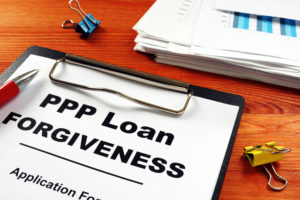 For companies in many industries, staying in business throughout 2020 was a struggle. It meant constantly adapting to new challenges, working harder than ever to just stay afloat and strategically taking advantage of state and federal relief efforts, like the Paycheck Protection Program (PPP), wherever possible.
For companies in many industries, staying in business throughout 2020 was a struggle. It meant constantly adapting to new challenges, working harder than ever to just stay afloat and strategically taking advantage of state and federal relief efforts, like the Paycheck Protection Program (PPP), wherever possible.
As a small business, we felt those struggles ourselves, and even as life starts to go back to ‘normal,’ we understand that the financial concerns of the last year are not going to just magically disappear.
Depending on what relief was utilized, many business owners are now considering their best strategy for repayment. In this blog, we’ll discuss your options and help you decide what’s best for your company.
The CARES Act, signed into law by former President Trump on March 27, 2020, initially set aside $349 billion in COVID-19 relief funds for small businesses through the PPP. Additional rounds of funding were later passed by Congress, with the final applications for the program accepted May 31, 2021.
Through the program, certain businesses could apply for and receive forgivable loans for payroll and other qualified expenses.
Loan amounts are applicable for forgiveness “if all retention criteria are met, and the funds are used for eligible expenses,” according to the U.S. Small Business Association.
More specifically, eligible borrowers qualify for full loan forgiveness if during the 8- to 24-week covered period:
- Employee and compensation levels were maintained
- The loan proceeds were spent on payroll costs and other eligible expenses; and
- At least 60% of the proceeds were spent on payroll costs
Businesses who utilized a second draw PPP loan are eligible for forgiveness under the same terms as their first PPP loan.
From a federal tax perspective, that forgiveness amount isn’t reported as taxable income and the qualified expenses related to the loan are also deductible, which was a major benefit of the PPP loans. However, as you’ll see below, not all states are in conformity.
When it comes to forgiveness, borrowers can apply once all loan proceeds have been utilized that the borrower is requesting forgiveness for. From that point forward, business owners can apply for forgiveness any time up to the maturity date of the loan. However, “if borrowers do not apply for forgiveness within 10 months after the last day of the covered period, then PPP loan payments are no longer deferred, and borrowers will begin making loan payments to their PPP lender.”
The application process for forgiveness can be found on the SBA website and requires certain documentation to be provided, including payroll and non-payroll records.
That said, the biggest question that many business owners are now facing is whether they should apply for forgiveness at all.
Another federal relief program, the Employee Retention Credit (ERC), is offered to companies that, within specific periods:
- Were forced to shut down the operation of their business because of governmental orders limiting “commerce, travel or group meetings due to COVID-19.”
OR
- Saw a decline of gross receipts in a specified calendar quarter that were less than 80% (50% in 2020) of the gross receipts in the same calendar quarter of 2019.
The program allows eligible businesses to claim a tax credit equal to 70% of the qualified wages they paid to employees for the period they are applying for.
While businesses were not initially allowed to utilize both programs, later legislation has allowed employers that received PPP loans to also claim the ERC for “qualified wages that are not treated as payroll costs in obtaining forgiveness of the PPP loan.”
What this means is that if qualified businesses choose to defer forgiveness and apply for the ERC, they could see overall greater savings and receive more funds in the long run, in part due to the low interest rates on PPP loans.
Businesses that have yet to take advantage of the credit for 2020 or 2021 have until April 15, 2025 to amend prior payroll tax returns, but the clock is ticking for PPP forgiveness applications.
That all said, it’s also important to factor in state responses to federal treatment of COVID-19 relief. Depending on the state, they may or may not treat PPP funds as taxable income.
A recent survey conducted by Bloomberg Tax & Accounting and reported on by CPA Practice Advisor found that 29 states indicated they will follow federal treatment of PPP loans, under 1160(i) of the CARES Act.
Our own home state of California has only partially conformed to the federal legislation on forgiveness of income and deductibility of expenses related to PPP loans. As explained in this article by Grant Thornton, businesses have to meet the qualifications of an eligible business. To be eligible to deduct the expenses, a taxpayer must have experienced a 25% or greater reduction in quarterly gross receipts for the first, second or third quarters of 2020 as compared to the same quarter of 2019.
As you decide the best path forward for your business, it’s important to consider your own state’s treatment of PPP funds. If you have questions regarding your loan, the SBA offers resources on its website to help clarify any concerns you have regarding it or other programs through the CARES Act.
If you have specific questions about state tax matters, please contact us today and we can clarify any aspects you’re trying to navigate.


















